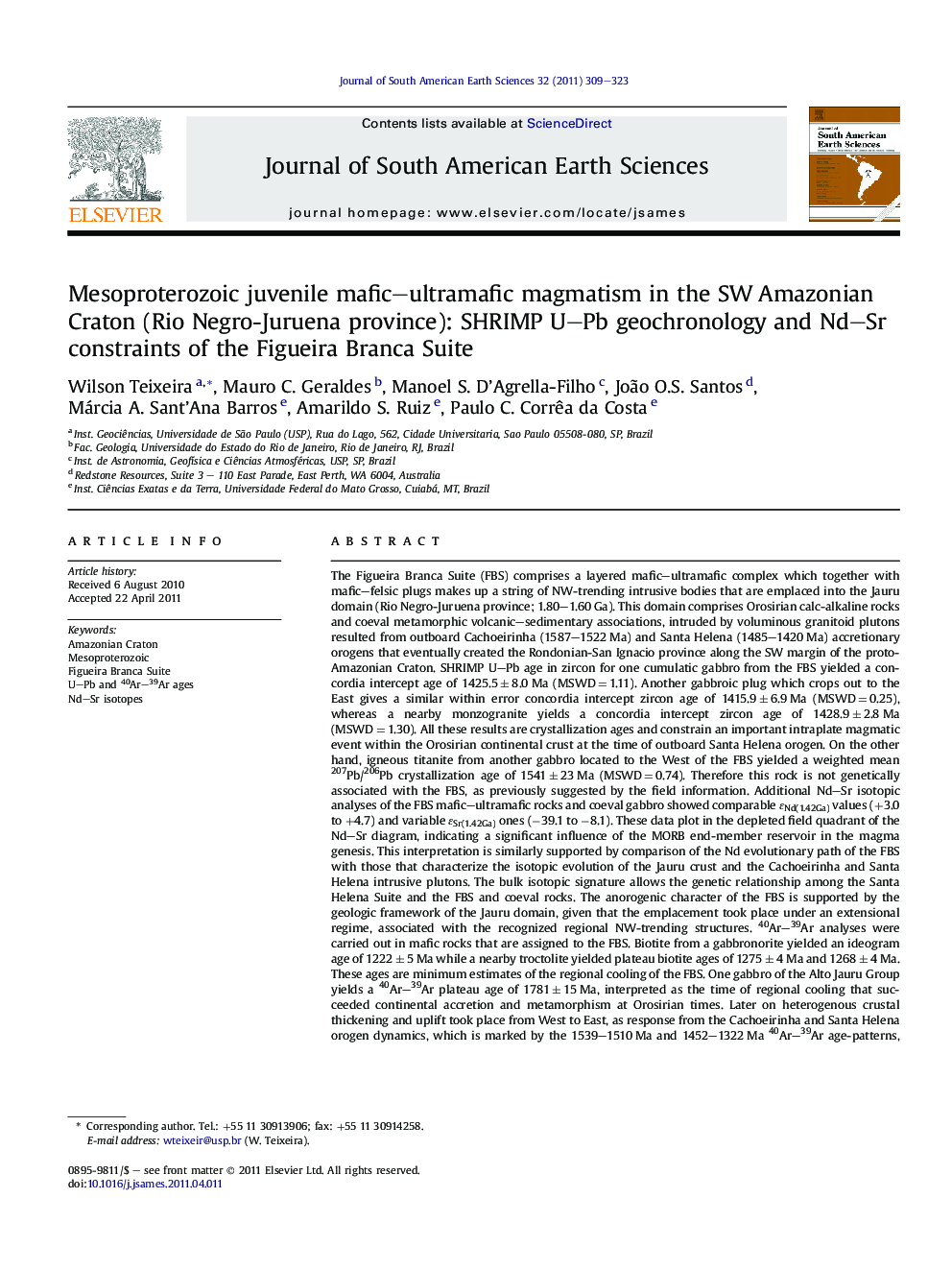| کد مقاله | کد نشریه | سال انتشار | مقاله انگلیسی | نسخه تمام متن |
|---|---|---|---|---|
| 4682592 | 1348929 | 2011 | 15 صفحه PDF | دانلود رایگان |

The Figueira Branca Suite (FBS) comprises a layered mafic–ultramafic complex which together with mafic–felsic plugs makes up a string of NW-trending intrusive bodies that are emplaced into the Jauru domain (Rio Negro-Juruena province; 1.80–1.60 Ga). This domain comprises Orosirian calc-alkaline rocks and coeval metamorphic volcanic–sedimentary associations, intruded by voluminous granitoid plutons resulted from outboard Cachoeirinha (1587–1522 Ma) and Santa Helena (1485–1420 Ma) accretionary orogens that eventually created the Rondonian-San Ignacio province along the SW margin of the proto-Amazonian Craton. SHRIMP U–Pb age in zircon for one cumulatic gabbro from the FBS yielded a concordia intercept age of 1425.5 ± 8.0 Ma (MSWD = 1.11). Another gabbroic plug which crops out to the East gives a similar within error concordia intercept zircon age of 1415.9 ± 6.9 Ma (MSWD = 0.25), whereas a nearby monzogranite yields a concordia intercept zircon age of 1428.9 ± 2.8 Ma (MSWD = 1.30). All these results are crystallization ages and constrain an important intraplate magmatic event within the Orosirian continental crust at the time of outboard Santa Helena orogen. On the other hand, igneous titanite from another gabbro located to the West of the FBS yielded a weighted mean 207Pb/206Pb crystallization age of 1541 ± 23 Ma (MSWD = 0.74). Therefore this rock is not genetically associated with the FBS, as previously suggested by the field information. Additional Nd–Sr isotopic analyses of the FBS mafic–ultramafic rocks and coeval gabbro showed comparable ɛNd(1.42Ga) values (+3.0 to +4.7) and variable ɛSr(1.42Ga) ones (−39.1 to −8.1). These data plot in the depleted field quadrant of the Nd–Sr diagram, indicating a significant influence of the MORB end-member reservoir in the magma genesis. This interpretation is similarly supported by comparison of the Nd evolutionary path of the FBS with those that characterize the isotopic evolution of the Jauru crust and the Cachoeirinha and Santa Helena intrusive plutons. The bulk isotopic signature allows the genetic relationship among the Santa Helena Suite and the FBS and coeval rocks. The anorogenic character of the FBS is supported by the geologic framework of the Jauru domain, given that the emplacement took place under an extensional regime, associated with the recognized regional NW-trending structures. 40Ar–39Ar analyses were carried out in mafic rocks that are assigned to the FBS. Biotite from a gabbronorite yielded an ideogram age of 1222 ± 5 Ma while a nearby troctolite yielded plateau biotite ages of 1275 ± 4 Ma and 1268 ± 4 Ma. These ages are minimum estimates of the regional cooling of the FBS. One gabbro of the Alto Jauru Group yields a 40Ar–39Ar plateau age of 1781 ± 15 Ma, interpreted as the time of regional cooling that succeeded continental accretion and metamorphism at Orosirian times. Later on heterogenous crustal thickening and uplift took place from West to East, as response from the Cachoeirinha and Santa Helena orogen dynamics, which is marked by the 1539–1510 Ma and 1452–1322 Ma 40Ar–39Ar age-patterns, respectively. The available apparent ages suggest that Cachoeirinha crust was subjected to a fast exhumation rate (ca. 50 m.y.), as estimated by the zircon–titanite–hornblende–biotite time-path, while the Santa Helena crust seems to display a lower exhumation rate. Particularly, the youngest 40Ar–39Ar biotite age (1322 Ma) available for the Santa Helena crust signals the post-tectonic phase of the Rondonian-San Ignacio province.
► Mafic–ultramafic complex and coeval felsic–mafic plugs as goals of this study.
► SHRIMP U–Pb zircon and Ar/Ar ages and Nd–Sr geochemistry as interpretative tools.
► We address the age and petrogenesis of these rocks and the tectonic significance.
► One Mesoproterozoic intraplate event is well established in the SW Amazonian Craton.
► Juvenile sources originated the magmatism, as reflect from outboard arc evolution.
Journal: Journal of South American Earth Sciences - Volume 32, Issue 4, December 2011, Pages 309–323